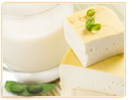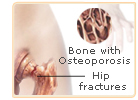How Soy Works
Among the many benefits of soybeans is the presence of isoflavones. Isoflavones make up a class of organic compounds that have beneficial health properties, are antioxidants and may even ward off disease. In mammals, they may act as phytoestrogens. Soybeans are the most common source of isoflavones in human food.
Soy Isoflavones
 Taking soy isoflavone concentrate is the easiest way to get soy isoflavones. Another way is to add soy germ to cereals or smoothies, or through cooked soybeans, miso, or tofu. Roasted soybeans have the highest isoflavone content, followed by tempeh, then soy flour. Processed soy products, including soy protein and soymilk, have the least amount of soy isoflavone out of the foods listed. It appears that one serving of soy foods a day may be enough to obtain the benefits of isoflavones. Taking soy isoflavone concentrate is the easiest way to get soy isoflavones. Another way is to add soy germ to cereals or smoothies, or through cooked soybeans, miso, or tofu. Roasted soybeans have the highest isoflavone content, followed by tempeh, then soy flour. Processed soy products, including soy protein and soymilk, have the least amount of soy isoflavone out of the foods listed. It appears that one serving of soy foods a day may be enough to obtain the benefits of isoflavones.
Continue reading below to learn how soy isoflavones are beneficial and how they work.
How Soy Isoflavones Work on the Body
The isoflavones in soy equipped it to fight against a number of diseases and relieve some ailments listed below.
Cancer: Soy isoflavones are similar to human estrogen allowing isoflavones to attach to estrogen receptors in human cells and blocking estrogen from doing the same. Isoflavones do no stimulate cells like estrogen keeping estrogen away from cells that are sensitive to estrogen. This helps prevent cancerous cells from forming in the bladder, breast, colon, prostate and skin.
 Fracture / Osteoporosis: Soy isoflavones strengthen bones resistance to fracture by moving calcium from the bloodstream into the bones. This also helps prevent osteoporosis. Clinical trials have established that soy isoflavones are a safe alternative to estrogen therapy in treating low bone mass or osteoporosis in women who have passed menopause. Fracture / Osteoporosis: Soy isoflavones strengthen bones resistance to fracture by moving calcium from the bloodstream into the bones. This also helps prevent osteoporosis. Clinical trials have established that soy isoflavones are a safe alternative to estrogen therapy in treating low bone mass or osteoporosis in women who have passed menopause.
Menopause-related problems: The mild estrogenic activity of soy isoflavones can ease menopause symptoms for some women, without creating estrogen-related problems. Studies show that menopausal women who consume soy food products had almost a 50 percent reduction in hot flashes and night sweats.
Psoriasis: The genistein in soy can reduces the formation of keratin which is a skin protein associated with psoriasis.
Diabetic Retinopathy: Diabetic retinopathy is an eye disorder, a complication suffered by diabetes patients. The genistein content of soy isoflavones allows them to fight the development of diabetic retinopathy.
As isoflavones work like estrogen, they may not be safe for women who already have breast cancer or who are pregnant. Soy isoflavones may also interfere with the action of oral contraceptives, although studies have not confirmed this.
Now that it�s been explained how soy works, click on the following link to learn about the different uses of soy.
Which herb should women try? Today women are looking for relief from their menopause symptoms with herbs. Phytoestrogenic herbs and non-estrogenic herbs are good in relieving menopause symptoms, but recent studies show that non-estrogenic herbs have no side effects because they help the body to produce its own hormones instead of introducing hormones like the phytoestrogenic ones. Learn more about non-estrogenic herbs for menopause.
| 

